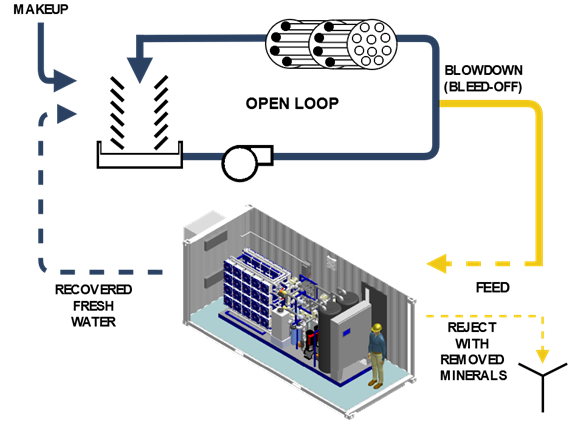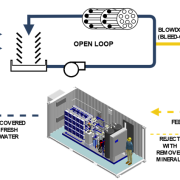Methods of blowdown treatment
In several power plants microrofiltration (MF) technology was used to treat and reuse cooling tower blowdown in a ZLD. The whole treatment process is not done only by MF and it was classified into pre- and post-treatment as follows;
- Chemical addition to the blowdown water to effect hardness (increase the PH up to 8.5) and silica removal (PH= 10-11) by precipitation.
- The precipitated solids are removed with microfiltration technology
۳.The MF treated water directed to a first-stage RO unit
- Portion of permeate is sent directly to the cooling tower as makeup water and the remainder to a polishing RO with its permeate treated with continuous deionization (CDI) technology for boiler feed.
- The concentrate stream from the first-stage RO unit is sent to a second-stage RO with its permeate utilized as cooling tower makeup and concentrate dewatered in a crystallizer.

RO in blowdown water treatment
Permeate flux and salt retention are the main parameters that determine the performance of an RO system. These parameters are mainly influenced by factors such as pressure and recovery. These variables influence the performance of the system in their own way. In practice, performances are usually influenced by multiple parameters [2].
The challenges in treating cooling tower blowdown
- The contaminated liquid is very high in solids. Treatment options for disposal of these liquids such as crystallizers require a large amount of thermal energy, a large footprint, and expensive corrosion-resistant materials.
- Evaporation ponds must be lined and may not be feasible in locations with limited space and low net evaporation rates;
- Wastewater can be collected and treated at offsite facilities when no onsite treatment is available.
[۱] Peter S. Cartwright, Cooling Tower Blowdown Treatment and Reuse, Water Conditioning & Purification, 2013.
[۲] Kaliapan S., Sathish C., T. Nirmalkumar, Recovery and reuse of water from effluents of cooling tower, J. Indian Inst. Sci., July–Aug. 2005, 85, 215–۲۲۱




دیدگاه خود را ثبت کنید
تمایل دارید در گفتگوها شرکت کنید؟در گفتگو ها شرکت کنید.